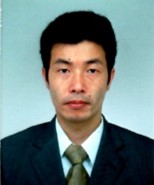|
Position |
Professor |
|
Research Field |
Nanotechnology/Materials / Structural organic chemistry and physical organic chemistry, Nanotechnology/Materials / Synthetic organic chemistry, Nanotechnology/Materials / Inorganic/coordination chemistry, Nanotechnology/Materials / Organic functional materials, Life Science / Bioorganic chemistry |
|
Homepage URL |
|
|
Mail Address |
|
|
External Link |
|
|
|
Graduating School 【 display / non-display 】
-
Chiba University Faculty of Science Graduated
1996.4 - 2000.3
Graduate School 【 display / non-display 】
-
Chiba University Graduate School, Division of Science and Technology Doctor's Course Completed
- 2005.3
Campus Career 【 display / non-display 】
-
KONAN UNIVERSITY Faculty of Science and Engineering Faculty of Science and Engineering Department of Chemistry of Functional Molecules Professor
2023.4
-
KONAN UNIVERSITY Faculty of Science and Engineering Faculty of Science and Engineering Department of Chemistry of Functional Molecules Associate Professor
2018.4 - 2023.3
-
KONAN UNIVERSITY Faculty of Science and Engineering Faculty of Science and Engineering Department of Chemistry of Functional Molecules Assistant Professor
2014.4 - 2018.3
External Career 【 display / non-display 】
-
徳島文理大学 香川薬学部
2005.4 - 2014.3
Country:Japan
Professional Memberships 【 display / non-display 】
Research Career 【 display / non-display 】
-
synthesis of supramolecular compounds with triarylphosphine oxide moiety
Project Year: 2014.4 -
-
Synthesis and Property of pseudorotaxane and rotaxane with phosphorus
Project Year: 2016.4 -
-
Preparation and luminescence property of lanthanide porous coordination polymer
Project Year: 2014.4 -
-
Relationship between polymorphism and luminescence property
Project Year: 2014.4 -
Papers 【 display / non-display 】
-
籠型超分子および多孔性配位高分子の細孔内ゲスト分子の挙動観測 Reviewed
片桐幸輔、川幡正俊
SPring-8/SACLA利用研究成果集 12 ( 2 ) 83 - 88 2024.5
Authorship:Lead author, Corresponding author
-
Investigating the synthesis and structure of [2]pseudorotaxanes assembled by crown ether as wheel component and dual-cation axle with phosphonium and ammonium cations Reviewed
Naoki Fujimoto, Koshiro Isono, Kosuke Katagiri
Journal of Molecular Structure 1259 132721_1 - 132721_6 2022.7
Authorship:Last author, Corresponding author Publisher:Elsevier {BV}
-
Oxaphosphacyclophanes Constructed from a Bis(triphenylphosphine oxide) Moiety Linked by Dioxyalkyl Chains: Synthesis and Crystal Structures Reviewed
Kosuke Katagiri, Masahiro Ohara, Masahiro Ikehara, Ikkei Higashimura, Koshiro Isono
ACS Omega 5 ( 37 ) 23621 - 23630 2020.9
Authorship:Lead author, Corresponding author Publisher:American Chemical Society ({ACS})
-
Photoreaction of anthracenyl phosphine oxides: Usual reversible photo- and heat-induced emission switching, and unusual oxidative P–C bond cleavage Reviewed
Kosuke Katagiri, Yukina Yamamoto, Yuhi Takahata, Ryoga Kishibe
Tetrahedron Letters 60 ( 30 ) 2026 2019.6
-
Aqua coordination to attenuate the luminescence properties of europium(III)-phosphine oxide porous coordination polymers Reviewed
Katagiri Kosuke, Matsuo Naoya, Kawahata Masatoshi, Masu Hyuma, Yamaguchi Kentaro
NEW JOURNAL OF CHEMISTRY 41 ( 16 ) 8305 - 8311 2017.8
Books and Other Publications 【 display / non-display 】
-
化合物から理解する大学の有機化学 必要な機器分析とともに
網本貴一、五十嵐康弘、入江亮、尾池秀章、片桐幸輔、斎藤英樹、徳田陽明、中村洋介、若狭雅信( Role: Joint author , 第1編3章(p.74~102)、第2編8章(p.204~208))
丸善出版株式会社 2023.10 ( ISBN:978-4-621-30861-5 )
Review Papers (Misc) 【 display / non-display 】
-
超分子相互作用による有機結晶の構造制御
片桐幸輔
化学と工業 69 ( 9 ) 744 - 745 2016.9
Authorship:Lead author Publishing type:Article, review, commentary, editorial, etc. (international conference proceedings) Publisher:日本化学会
-
Synthesis and Structure of Silver(I) Coordination Polymers with Bis(pyridyl) Ligands Linked by an Aromatic Sulfonamide
Kosuke Katagiri
134 ( 9 ) 939 - 947 2014.5
Authorship:Lead author Publishing type:Article, review, commentary, editorial, etc. (international conference proceedings) Publisher:The Pharmaceutical Society of Japan
Academic Awards Received 【 display / non-display 】
-
日本薬学会中国四国支部奨励賞
2013.10 日本薬学会中国四国支部
片桐幸輔
Other External funds procured 【 display / non-display 】
-
希土類配位高分子材料の発光挙動機構解明
2022.4 - 2023.3
公益財団法人木下記念事業団 公益財団法人木下記念事業団学術研究活動助成
Authorship:principal_investigator
Preferred joint research theme 【 display / non-display 】
-
結晶多形と発光挙動相関
-
希土類多孔性配位高分子の発光色制御
Committee Memberships 【 display / non-display 】
-
2025.4 有機合成化学協会関西支部 幹事
-
2022.4 - 2024.3 日本化学会近畿支部 幹事
-
2020.5 - 2021.3 日本化学会 第102春季年会 講演企画小委員会
-
2018.5 - 2019.3 日本化学会 第99春季年会 講演企画小委員会



